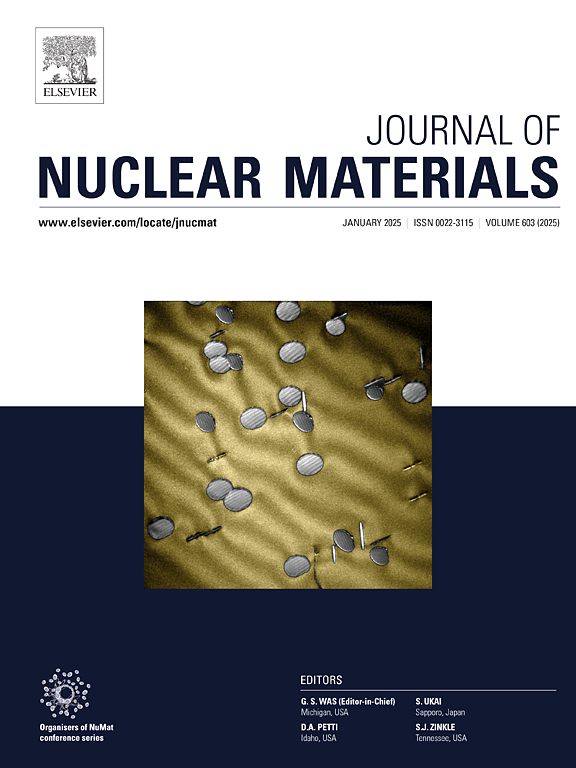Irradiation stability of M23C6 in representative reduced activation ferritic martensitic steels
IF 2.8
2区 工程技术
Q3 MATERIALS SCIENCE, MULTIDISCIPLINARY
引用次数: 0
Abstract
The irradiation stability of M23C6 precipitates in three reduced activation ferritic/martensitic steels (RAFMs) was investigated following irradiation of high-energy protons and neutrons at doses up to 21 dpa and temperatures up to 520°C in the targets of the Swiss Spallation Neutron Source. M23C6 precipitates in specimens before and after irradiation were characterized using atom probe tomography. The concentrations of Mn, Si, P and N increased significantly in M23C6 precipitates, while the W concentration in M23C6 precipitates decreased with increasing irradiation temperature. The spallation transmutation elements Ti, Sc, Ca and K were enriched in the M23C6 precipitates of irradiated specimens, The enriched elements also showed strong segregation at the M23C6-matrix interface. Cr-rich clusters and small α’ precipitates were observed near the M23C6 precipitates in F82H and Eurofer 97 specimens irradiated at about 20 dpa and 300°C. At higher irradiation temperatures (480°C and 520°C), Fe-rich clusters were formed inside M23C6 precipitates.
M23C6在代表性低活化铁素体马氏体钢中的辐照稳定性
在瑞士散裂中子源靶材中,在高达21 dpa的高能质子和中子照射下,在高达520℃的温度下,研究了三种还原活化铁素体/马氏体钢(rafm)中M23C6沉淀的辐照稳定性。采用原子探针层析技术对辐照前后样品中的M23C6析出物进行了表征。随着辐照温度的升高,M23C6析出相中Mn、Si、P和N的浓度显著升高,而W的浓度则显著降低。辐照试样的M23C6析出相中富集了散裂嬗变元素Ti、Sc、Ca和K,富集元素在M23C6-基体界面处表现出强烈的偏析。F82H和Eurofer 97样品在约20 dpa和300°C辐照下,在M23C6析出物附近观察到富cr团簇和小α′析出物。在较高的辐照温度(480℃和520℃)下,M23C6析出物内部形成富铁团簇。
本文章由计算机程序翻译,如有差异,请以英文原文为准。
求助全文
约1分钟内获得全文
求助全文
来源期刊

Journal of Nuclear Materials
工程技术-材料科学:综合
CiteScore
5.70
自引率
25.80%
发文量
601
审稿时长
63 days
期刊介绍:
The Journal of Nuclear Materials publishes high quality papers in materials research for nuclear applications, primarily fission reactors, fusion reactors, and similar environments including radiation areas of charged particle accelerators. Both original research and critical review papers covering experimental, theoretical, and computational aspects of either fundamental or applied nature are welcome.
The breadth of the field is such that a wide range of processes and properties in the field of materials science and engineering is of interest to the readership, spanning atom-scale processes, microstructures, thermodynamics, mechanical properties, physical properties, and corrosion, for example.
Topics covered by JNM
Fission reactor materials, including fuels, cladding, core structures, pressure vessels, coolant interactions with materials, moderator and control components, fission product behavior.
Materials aspects of the entire fuel cycle.
Materials aspects of the actinides and their compounds.
Performance of nuclear waste materials; materials aspects of the immobilization of wastes.
Fusion reactor materials, including first walls, blankets, insulators and magnets.
Neutron and charged particle radiation effects in materials, including defects, transmutations, microstructures, phase changes and macroscopic properties.
Interaction of plasmas, ion beams, electron beams and electromagnetic radiation with materials relevant to nuclear systems.
 求助内容:
求助内容: 应助结果提醒方式:
应助结果提醒方式:


